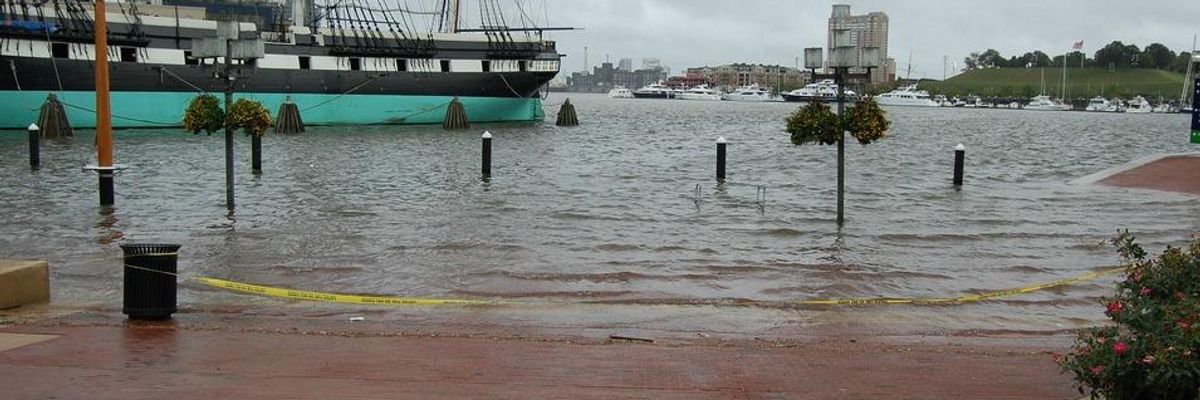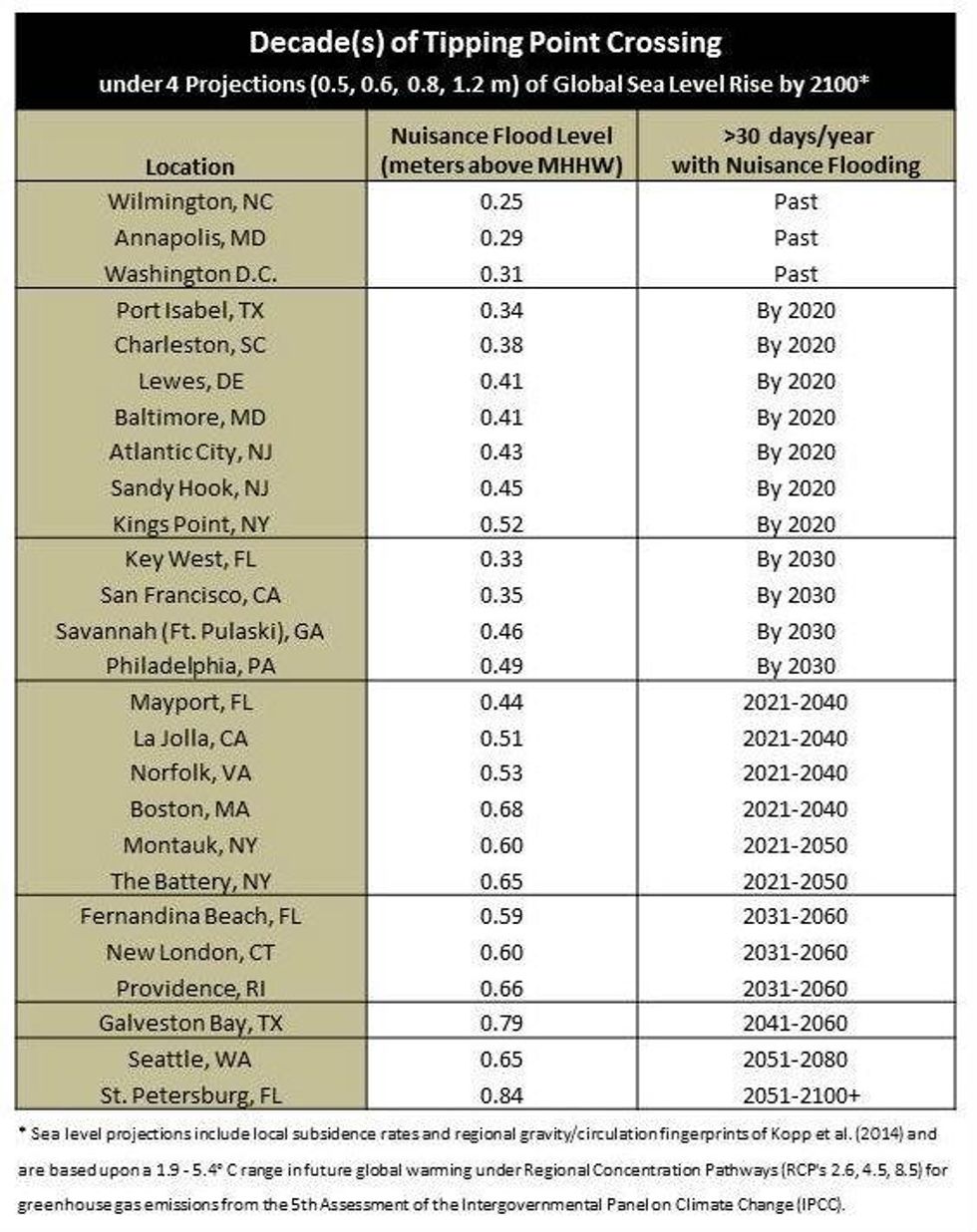

SUBSCRIBE TO OUR FREE NEWSLETTER
Daily news & progressive opinion—funded by the people, not the corporations—delivered straight to your inbox.
5
#000000
#FFFFFF
To donate by check, phone, or other method, see our More Ways to Give page.


Daily news & progressive opinion—funded by the people, not the corporations—delivered straight to your inbox.

Floods like this 2010 one in Baltimore will become increasingly frequent occurrences, NOAA says. (Photo: Andy Mangold/flickr/cc)
By 2050, a majority of U.S. coastal areas--including urban centers such as Baltimore, Philadelphia, San Francisco, and Boston--will likely be threatened by 30 or more days of flooding each year due to dramatically accelerating sea level rise, according to a new study by the National Oceanic and Atmospheric Administration (NOAA).
The paper, "From the Extreme to the Mean: Acceleration and Tipping Points for Coastal Inundation due to Sea Level Rise," was published Thursday in the American Geophysical Union's online peer-reviewed journal Earth's Future.
Taking into account recent projections for global sea level rise as well as local factors such as frequency of storms and the settling or sinking of land, the NOAA scientists found that 'nuisance flooding'--defined by NOAA's National Weather Service as flooding between one to two feet above local high tide--will cross a tipping point over the next several decades.
"Coastal communities are beginning to experience sunny-day nuisance or urban flooding, much more so than in decades past," said NOAA oceanographer William Sweet, who co-authored the paper. "This is due to sea level rise. Unfortunately, once impacts are noticed, they will become commonplace rather quickly. We find that in 30 to 40 years, even modest projections of global sea level rise--1 1/2 feet by the year 2100--will increase instances of daily high tide flooding to a point requiring an active, and potentially costly response, and by the end of this century, our projections show that there will be near-daily nuisance flooding in most of the locations that we reviewed."
The NOAA team projects that Boston; New York City; Philadelphia; Baltimore; Washington, D.C.; Norfolk, Virginia; and Wilmington, North Carolina will soon make, or are already being forced to make, decisions on how to mitigate these nuisance floods earlier than planned. In the Gulf, NOAA forecasts earlier-than-anticipated floods for Galveston Bay and Port Isabel, Texas. Along the Pacific coast, earlier impacts will be most visible in the San Diego and San Francisco Bay areas.

Mitigation measures could range from retreating further inland to coastal fortification to implementation of infrastructure such as sea walls and redesigned storm water systems.
Although the 'nuisance' classification doesn't impart much urgency, Earth's Future editor Michael Ellis points out: "The paper also raises the interesting question of what frequency of 'nuisance' corresponds to a perception of 'this is no longer a nuisance but a serious hazard due to its rapidly growing and cumulative impacts'."
Common Dreams is powered by optimists who believe in the power of informed and engaged citizens to ignite and enact change to make the world a better place. We're hundreds of thousands strong, but every single supporter makes the difference. Your contribution supports this bold media model—free, independent, and dedicated to reporting the facts every day. Stand with us in the fight for economic equality, social justice, human rights, and a more sustainable future. As a people-powered nonprofit news outlet, we cover the issues the corporate media never will. |
By 2050, a majority of U.S. coastal areas--including urban centers such as Baltimore, Philadelphia, San Francisco, and Boston--will likely be threatened by 30 or more days of flooding each year due to dramatically accelerating sea level rise, according to a new study by the National Oceanic and Atmospheric Administration (NOAA).
The paper, "From the Extreme to the Mean: Acceleration and Tipping Points for Coastal Inundation due to Sea Level Rise," was published Thursday in the American Geophysical Union's online peer-reviewed journal Earth's Future.
Taking into account recent projections for global sea level rise as well as local factors such as frequency of storms and the settling or sinking of land, the NOAA scientists found that 'nuisance flooding'--defined by NOAA's National Weather Service as flooding between one to two feet above local high tide--will cross a tipping point over the next several decades.
"Coastal communities are beginning to experience sunny-day nuisance or urban flooding, much more so than in decades past," said NOAA oceanographer William Sweet, who co-authored the paper. "This is due to sea level rise. Unfortunately, once impacts are noticed, they will become commonplace rather quickly. We find that in 30 to 40 years, even modest projections of global sea level rise--1 1/2 feet by the year 2100--will increase instances of daily high tide flooding to a point requiring an active, and potentially costly response, and by the end of this century, our projections show that there will be near-daily nuisance flooding in most of the locations that we reviewed."
The NOAA team projects that Boston; New York City; Philadelphia; Baltimore; Washington, D.C.; Norfolk, Virginia; and Wilmington, North Carolina will soon make, or are already being forced to make, decisions on how to mitigate these nuisance floods earlier than planned. In the Gulf, NOAA forecasts earlier-than-anticipated floods for Galveston Bay and Port Isabel, Texas. Along the Pacific coast, earlier impacts will be most visible in the San Diego and San Francisco Bay areas.

Mitigation measures could range from retreating further inland to coastal fortification to implementation of infrastructure such as sea walls and redesigned storm water systems.
Although the 'nuisance' classification doesn't impart much urgency, Earth's Future editor Michael Ellis points out: "The paper also raises the interesting question of what frequency of 'nuisance' corresponds to a perception of 'this is no longer a nuisance but a serious hazard due to its rapidly growing and cumulative impacts'."
By 2050, a majority of U.S. coastal areas--including urban centers such as Baltimore, Philadelphia, San Francisco, and Boston--will likely be threatened by 30 or more days of flooding each year due to dramatically accelerating sea level rise, according to a new study by the National Oceanic and Atmospheric Administration (NOAA).
The paper, "From the Extreme to the Mean: Acceleration and Tipping Points for Coastal Inundation due to Sea Level Rise," was published Thursday in the American Geophysical Union's online peer-reviewed journal Earth's Future.
Taking into account recent projections for global sea level rise as well as local factors such as frequency of storms and the settling or sinking of land, the NOAA scientists found that 'nuisance flooding'--defined by NOAA's National Weather Service as flooding between one to two feet above local high tide--will cross a tipping point over the next several decades.
"Coastal communities are beginning to experience sunny-day nuisance or urban flooding, much more so than in decades past," said NOAA oceanographer William Sweet, who co-authored the paper. "This is due to sea level rise. Unfortunately, once impacts are noticed, they will become commonplace rather quickly. We find that in 30 to 40 years, even modest projections of global sea level rise--1 1/2 feet by the year 2100--will increase instances of daily high tide flooding to a point requiring an active, and potentially costly response, and by the end of this century, our projections show that there will be near-daily nuisance flooding in most of the locations that we reviewed."
The NOAA team projects that Boston; New York City; Philadelphia; Baltimore; Washington, D.C.; Norfolk, Virginia; and Wilmington, North Carolina will soon make, or are already being forced to make, decisions on how to mitigate these nuisance floods earlier than planned. In the Gulf, NOAA forecasts earlier-than-anticipated floods for Galveston Bay and Port Isabel, Texas. Along the Pacific coast, earlier impacts will be most visible in the San Diego and San Francisco Bay areas.

Mitigation measures could range from retreating further inland to coastal fortification to implementation of infrastructure such as sea walls and redesigned storm water systems.
Although the 'nuisance' classification doesn't impart much urgency, Earth's Future editor Michael Ellis points out: "The paper also raises the interesting question of what frequency of 'nuisance' corresponds to a perception of 'this is no longer a nuisance but a serious hazard due to its rapidly growing and cumulative impacts'."